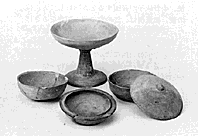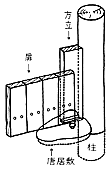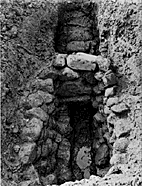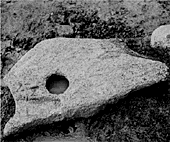|

Clay utensils found at the site of Asuka Kawara-no-miya.


Drainage ditch where wooden clog was found at site of Asuka Kawara-no-miya.
|
|
ASUKA KAWARA-NO-MIYA (655-656)
It was here that Empress Saimei transferred her residence in the winter of 655, in the wake of the fire which had destroyed the Asuka Itabuki-no-miya, where she had assumed rulership (for the second time) earlier the same year. When excavation studies were made at the Kawaradera, it was discovered that there were drainage ditches predating the construction of the temple, and among the artifacts unearthed therefrom were a comb, a geta (wooden clog), and clay utensils. These drainage ditches are thought to be part of the construction of the Asuka Kawara-no-miya. Further discovery brought to light the stone receptacles (kara-ishiki) which housed the bottom ends of the pivot-and-hole type shafts that formed part of the structure of the palace doors.

Wooden clog, Kawara-no-miya.
Kara-ishiki of the Kawara-no-miya.
A kara-ishiki is a stone used as a receptacle for a door shaft. In contrast to the kara-ishiki used in the foundation-stone type construction of the Kawaradera, the kara-ishiki of the Kawara-no-miya, in addition to having cavities hollowed into the stones themselves, were designed to have affixed to their sides deep-set hottate-bashira (see page 8),from which fact we may surmise that the doors were part of a hottate-bashira type building.

|
|